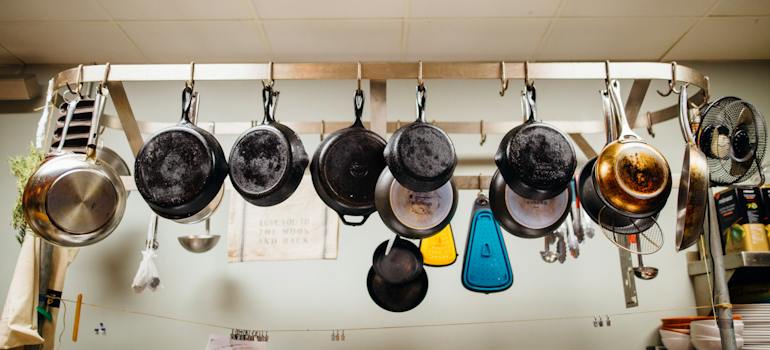The most tedious aspect of moving is packing. This is even more true when it comes to one of the most used and complex rooms in your home, the kitchen. With its delicate glassware, bulky appliances, and numerous small utensils, the task of packing your kitchen can seem like a nightmare. However, with the right approach and organization, it can be tackled efficiently and effectively. In fact, there are specific steps you should take to pack your kitchen for the move correctly. Whether you’re a seasoned mover or a first-timer, this kind of approach will ensure that your kitchen arrives at your new home safe, organized, and ready for your next culinary adventure.
Take a minute to plan this task
Before you start, you should make an efficient plan. Decluttering should be the first item of it. Separate your kitchen items into categories such as ‘keep’, ‘donate’, ‘discard’, and ‘store’. This both simplifies packing and reduces the load, potentially lowering moving costs. While you’re at it, create a detailed inventory of items you’re moving, especially valuable or fragile pieces. This list will be invaluable for tracking your belongings and ensuring everything arrives safely.
Next, plan your packing schedule. Start with rarely used items and save everyday essentials for last. Moreover, allocate time each day for packing, so it doesn’t become overwhelming. With proper planning and organization, you are going to be one step closer to a smooth and efficient move.
Get the proper packing supplies
Having the right packing supplies will make things a lot easier. Firstly, you need to gather strong, durable boxes in various sizes. For example, small boxes are ideal for heavy items like canned goods or books. On the other hand, medium to large boxes are better suited for lighter items such as plastic kitchenware or small appliances. Additionally, ensure you have plenty of bubble packs, packing paper, and packing tape for securing items. Of course, if this is too much for you or you don’t have time for it, you can always rely on the packing service Northern Virginia companies provide.
Don’t forget to include markers for labeling and plastic bags for grouping small items. Bear in mind that quality materials can make a significant difference in protecting your belongings. Investing in good supplies, or opting for a professional packing service, can help safeguard your kitchen essentials throughout the moving process.

Fragile items require more attention when packing
To properly pack your kitchen for the move, don’t forget the delicate pieces you own. Those include your grandmother’s china and your favorite wine glasses. These items need more than just a bubble pack. Begin by cushioning the bottom of your boxes with crumpled packing paper or foam peanuts. Each glass, plate, or fragile item should be individually wrapped in a bubble pack, and secured with packing tape. When placing them in boxes, avoid overpacking. Instead, allow enough room for a protective layer between items. For extra safety, and it’s a piece of advice from Northern Virginia movers and other professional moving companies, consider double-boxing your most delicate items. This involves placing your wrapped items in a smaller box and then placing that box inside a larger, padded one. Always label these boxes as “Fragile” to ensure careful handling. This meticulous approach reduces the risk of damage during transit, ensuring your cherished items arrive intact.
To properly pack your kitchen for the move, handle your small appliances correctly
If you deal with your small appliances and gadgets properly during this move, you will have them ready to use immediately after your relocation is over. Make sure you clean and dry them first. Afterward, remove any detachable parts, such as blades from blenders or racks from toasters. Those should be wrapped separately in a bubble pack or packing paper. Secure the cords to the appliances to prevent tangling. If you still have them, the original boxes and packaging are ideal for transport as they provide the perfect fit.
For those who prefer a more hands-off approach, consider enlisting the help of professional moving companies Mount Vernon or your local area provides. These companies often offer specialized packing services, ensuring your appliances are packed securely and efficiently.
The proper way of packing pots, pans, and cookware
In packing your pots, pans, and cookware for the move, select sturdy boxes of medium to large size. Begin with the heaviest and largest items, placing them at the base of the box. To optimize space, nest smaller pots within the larger ones, using layers of packing paper or bubble wrap in between to prevent scratches and damage. Moreover, individually wrap the lids and place them alongside the pots, rather than on top, to avoid any undue pressure. It’s important to fill any remaining gaps in the box with packing paper or towels to secure the contents and prevent shifting during transit. For particularly heavy items like cast iron skillets, it’s advisable to pack them separately in smaller boxes to distribute weight evenly.

Food items – what to pack and what not to pack
And what about food? Non-perishable items like canned goods, spices, and sealed packages can be packed and moved to your new home. However, perishable items like fresh produce, meat, and open packages should be used up, donated, or discarded before moving day to avoid spoilage and waste.
For those who have a surplus of non-perishable items or are facing a delay in moving to a new residence, utilizing self storage Lorton VA solution, or your local area, can be very practical. This way, non-essentials can be safely stored without cluttering your new space. Before depositing them into your unit, label the boxes clearly and create an inventory to keep track of what you have stored.

Leave the essentials for the end
As your moving day approaches, prepare an ‘essentials box’ for your first few days in the new home. This box should include items you’ll need immediately upon arrival, such as:
- Basic cookware (a pot, a pan)
- A few dishes, cups, and utensils
- Dish soap and a sponge
- A small coffee maker or kettle
- Basic pantry items (coffee, tea, snacks)
Label this box clearly and keep it easily accessible, either with you or loaded last onto the moving truck.
Closing your kitchen packing chapter
It’s clear that to properly pack your kitchen for the move, you’ll need some careful planning, organization, and attention to detail. Keep in mind that the key to a successful move is not just in the packing itself, but in the approach: stay calm, give yourself enough time, and tackle one task at a time. With these tips, you’ll do the job a lot faster than expected, and your new kitchen will be perfectly organized from day one.


